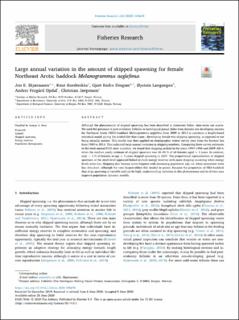Large annual variation in the amount of skipped spawning for female Northeast Arctic haddock Melanogrammus aeglefinus
Skjæraasen, Jon Egil; Korsbrekke, Knut; Dingsør, Gjert Endre; Langangen, Øystein; Opdal, Anders Frugård; Jørgensen, Christian
Peer reviewed, Journal article
Published version
Permanent lenke
https://hdl.handle.net/11250/2723110Utgivelsesdato
2020Metadata
Vis full innførselSamlinger
- Articles [3009]
- Publikasjoner fra CRIStin [3056]
Sammendrag
Although the phenomenon of skipped spawning has been described in numerous fishes, time-series are scarce. We used the presence of post-ovulatory follicles in histological gonad slides from females not developing oocytes for Northeast Arctic (NEA) haddock Melanogrammus aeglefinus from 2009 to 2012 to construct a length-based statistical model giving the probability that a non - developing female was skipping spawning, as opposed to not being sexually mature. This model was then applied on demographic winter survey data from the Barents Sea from 1989 to 2014. This indicated large annual variation in skipping numbers. Comparing these survey estimates to the total annual ICES stock numbers, we found that skipping peaked in the years 1994–1996 and 2009–2014, when the median yearly estimate of skipped spawners was 20–45 % of all females aged ≥ 3 years. In contrast, only ∼ 3 % of females at age ≥ 3 years skipped spawning in 2007. The proportional representation of skipped spawners at the stock level appeared linked to stock energy reserves with more skipping occurring when energy levels were low. Skipping also became more frequent with increasing population age, i.e. when immatures were less abundant, although the very largest/oldest fish tended to spawn. Because the proportion of NEA haddock that skips spawning is variable and can be high, understanding variation in this phenomenon and its drivers may improve population dynamic models.
